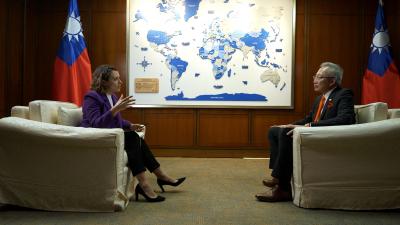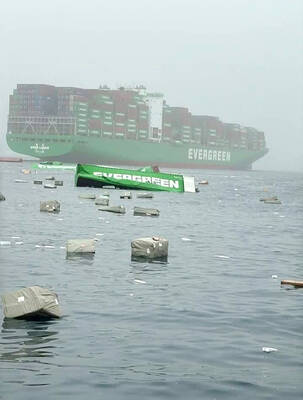Once the seat of the Taiwan Provincial Government, Jhongsing New Village (中興新村), a planned community founded in 1956 in Nantou County, has nearly become a ghost town.
At its peak, when the Taiwan Provincial Government was still an effective entity, the pastoral village had a population of 11,000. Constitutional changes in 1997 transferred most of the Taiwan Provincial Government’s authority and responsibilities to the central government, essentially turning it into a nominal institution and resulting in a large population outflow as government employees relocated.
Only about 4,600 people still live in the village, where a significant number of buildings have been abandoned and damage caused by the 921 Earthquake in 1999 is still visible.

Photo: Chen Wei-han, Taipei Times
In 2008, a proposal to rejuvenate the 259 hectare community was proposed by then-president Ma Ying-jeou (馬英九) as part of his “12 Love Taiwan Construction Projects,” which had been bedrock of his election campaign. The proposal was aimed at transforming the village into a new research center for emerging and advanced technology.
The NT$11.9 billion (US$365.84 million at the current exchange rate) Advanced Research Park project was announced the next year, which was designed to house 250 research and development facilities, provide 13,000 new jobs and introduce 16,500 new residents to repopulate the village and revive the local economy.
The park was supposed to focus on high-tech research and development, as well as the cultural creative industry, but no manufacturing was allowed, as 90 percent of the village has been designated as cultural sites by the Nantou County Government.
“The idea behind the Advanced Research Park project was to transform the village into a large living lab where cutting-edge technology can be tested, such as a remote healthcare system, smart home devices, ‘green’ energy and intelligent transportation systems,” then-deputy minister of science and technology Lin Yi-bing (林一平) said earlier this month.
A glimpse of a bright future was shown: a smart home converted from an old dormitory in the village. A solar power system generates enough electricity to sustain the structure and six other households, while a healthcare system that monitors residents’ conditions allows for remote medical diagnoses and interfaces inside the house interact with residents based on their mental and physical status.
Another highlight was the Ministry of Economic Affairs’ (MOEA) Central Taiwan Innovation Campus, a modern building that is also one of the greenest structures in Taiwan, using 57 percent less electricity than comparable normal buildings and was the nation’s first building to be recognized with two top green building awards. The incubator helps facilitate cooperation between companies, start-ups and government agencies.
“Only knowledge-based research facilities are eligible to operate in the park, and the industry cluster effect is growing as more entities enter the park,” Lin said.
However, despite being well-envisioned, the Advanced Research Park might fall short of success.
To date, the government has spent NT$6.1 billion on the project since 2010, NT$5.5 billion of which was used to expropriate properties in the park’s south, and the project is expected to cost another NT$5.8 billion by 2020, according to the Central Taiwan Science Park, the authority and developer of the Advanced Research Park.
Despite the size of the investment, the research park’s occupancy rate remains a disappointing 21.64 percent, with four small and medium-sized enterprises and the MOEA’s incubator employing only 429 workers.
The nation’s largest footwear manufacturer, Pou Chen Group, and fertilizer manufacturer CH Biotech earlier this year announced they would establish a presence in the research park. The two companies are to create about 600 new jobs, which, combined with jobs offered by existing organizations at the park, is far from the project’s target of 13,000 jobs.
Nantou County Commissioner Lin Ming-chen (林明溱) last year expressed his doubts over the research park’s ability to attract businesses at a conference held to promote investment in the facility, saying there was a huge gap between the developer’s vision and reality, as few companies have been willing to establish operations in it.
The success of a science or industrial park depends on the creation of an industry cluster that connects different, yet interdependent businesses, including manufacturers, research facilities, intermediary agencies, such as incubators, and client companies. However, the peculiarities of the village to a large extent prevent the formation of an effective industry cluster.
As most of the village has been designated as cultural sites and cannot be changed, there is only a 48 hectare plot in the research park’s south in which companies can set up shop. After accounting for government agencies already established in the area, potential investors would be left with only about 24 hectares, compared with hundreds of hectares at other science parks in the nation.
Taking into account space to be occupied by incoming businesses leaves only 8 hectares, which can accommodate a few more facilities at best, meaning the Advanced Research Park is nearing its capacity just as it begins to establish an industry cluster and intensive economy.
Despite being upbeat about the site’s potential, Central Taiwan Science Park director Wayne Wang (王永壯) said it would be difficult for the government to recoup the development costs.
“The park is not expected to generate gross output value, because it is research oriented, while the administration aims to revive the village and serve residents with advanced technology,” Wang said, adding that a number of government agencies are to introduce residents to the latest technologies to improve their quality of life.
A number of government and semi-government bodies, including the Ministry of Science and Technology, the economics ministry, the Ministry of Culture, the Council of Agriculture, the Industrial Technology Research Institute and Academia Historica plan to establish operations or test their latest inventions in the park.
That being said, the multibillion-dollar project might turn the village into a science park chimera, where government agencies outnumber the handful of private businesses, resulting in a living lab that would serve as government units’ exhibition center.
When asked how the Advanced Research Park differs from normal science or industrial parks and why companies would prefer it to other parks where they can engage in research and production, Wang said companies might be willing to operate in the village as most science parks are nearly full and Nantou is easily accessible.
However, according to the National Audit Office’s latest annual audit report in 2014, the science ministry has repeatedly been blamed for high vacancy rates at several of the nation’s 13 science parks.
According to the report, science parks had a rentable area of 1,534.73 hectares, 89.51 percent of which was leased, while five parks had a more than 20 percent vacancy rate, including the Advanced Research Park and Kaohsiung Science Park, while the occupancy rates of standardized factory facilities at both Tainan Science Park and Kaohsiung Science Park were less than 80 percent.
“The office has on many occasions requested that the Ministry of Science and Technology improve occupancy rates at science parks, but follow-up assessment has shown there is still room for improvement, so the ministry is again requested to make improvements and re-examine its policies,” the report said.
The Science Park Operation Fund is NT$126.6 billion in debt, but the government, which has not fully utilized vacant space in parks, has continued development of the Advanced Research Park, despite its minimal output value, giving the impression the project is an unrecoverable investment made with taxpayers’ money.
Whether that money has been spent wisely to rejuvenate Jhongsing New Village can only be judged in a few years’ time, but residents continue to look for a bright future 20 years after the nation’s political center moved away.

“China is preparing to invade Taiwan,” Deputy Minister of Foreign Affairs Francois Wu (吳志中) said in an exclusive interview with British media channel Sky News for a special report titled, “Is Taiwan ready for a Chinese invasion?” the Ministry of Foreign Affairs said today in a statement. The 25-minute-long special report by Helen Ann-Smith released yesterday saw Sky News travel to Penghu, Taoyuan and Taipei to discuss the possibility of a Chinese invasion and how Taiwan is preparing for an attack. The film observed emergency response drills, interviewed baseball fans at the Taipei Dome on their views of US President

ECONOMIC BENEFITS: The imports from Belize would replace those from Honduras, whose shrimp exports have dropped 67 percent since cutting ties in 2023 Maintaining ties with Taiwan has economic benefits, Ministry of Foreign Affairs officials said yesterday, citing the approval of frozen whiteleg shrimp imports from Belize by the Food and Drug Administration (FDA) as an example. The FDA on Wednesday approved the tariff-free imports from Belize after the whiteleg shrimp passed the Systematic Inspection of Imported Food, which would continue to boost mutual trade, the ministry said. Taiwan’s annual consumption of whiteleg shrimps stands at 30,000 tonnes, far exceeding domestic production, the ministry said. Taiwan used to fill the gap by importing shrimps from Honduras, but purchases slumped after Tegucigalpa severed diplomatic ties with Taiwan

The Executive Yuan yesterday approved a southwestern extension of the Sanying MRT Line from New Taipei to Bade District (八德) in Taoyuan, with a goal of starting construction by late 2026. The 4.03-kilometer extension, featuring three new stations, will run from the current terminus at Yingtao Fude Station (LB12) in New Taipei City to Dannan Station (LB14), where it will connect with Taoyuan’s Green Line, New Taipei City Metro Corp said in a statement. This extension will follow the completion of core Sanying Line, a 14.29-kilometer medium-capacity system linking Tucheng (土城), Sansia (三峽)

CARGO LOSS: About 50 containers at the stern of the ‘Ever Lunar’ cargo ship went overboard, prompting the temporary closure of the port and disrupting operations Evergreen Marine Corp, Taiwan’s largest container shipper, yesterday said that all crew members aboard the Ever Lunar (長月) were safe after dozens of containers fell overboard off the coast of Peru the previous day. The incident occurred at 9:40am on Friday as the Ever Lunar was anchored and waiting to enter the Port of Callao when it suddenly experienced severe rolling, Evergreen said in a statement. The rolling, which caused the containers to fall, might have been caused by factors including a tsunami triggered by an earthquake in Russia, poor winter sea conditions in South America or a sudden influx of waves,